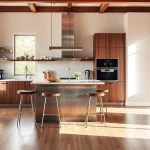Defining Aesthetic Appeal in UK Homes
Understanding aesthetic appeal in UK home design extends beyond mere decoration. It involves the harmonious blend of architectural features, colour palettes, and landscaping that together enhance a property’s visual attractiveness. In residential architecture, this appeal is measured by how well elements complement each other, creating a balanced and inviting appearance.
One crucial aspect is curb appeal, which refers to the immediate impression a house makes from the street. In the UK housing market, this first impression can significantly affect a property’s desirability and value. A well-maintained exterior, appropriate use of traditional materials, and thoughtful design choices contribute to the overall aesthetic appeal.
In parallel : How Does the UK Housing Market Affect First-Time Homebuyers?
The goal is to achieve visual harmony—where every element, from windows to garden layouts, works cohesively. This is especially important when buyers or visitors form an opinion within seconds of seeing a home. A high level of aesthetic appeal not only attracts attention but also invites a positive emotional response, making it a powerful factor in UK home design success.
Impact of Architectural Styles and Period Features
Architectural styles in the UK range widely, with Victorian homes, Georgian homes, and modern constructions each offering distinctive characteristics. Victorian homes are renowned for their ornate details, bay windows, and intricate brickwork, while Georgian homes showcase symmetry, sash windows, and classical proportions. Edwardian properties blend some Victorian features with lighter, more spacious interiors.
Also to read : What Are the Key Factors to Consider When Renovating a Home in the UK?
Original period features add significant aesthetic value to these properties. Elements such as cornices, ceiling roses, and wooden paneling enhance the character and charm that new builds often lack. These features also influence how renovations or modern integrations are approached, preserving heritage while accommodating contemporary needs.
Contrasting traditional Victorian or Georgian designs with modern architectural elements creates vivid blends that appeal to diverse tastes. For example, combining sash windows with sleek, minimalist interiors showcases a balance between traditional vs modern homes. Homeowners and designers often leverage this mix to maintain historical integrity while introducing modern functionality and style. This approach respects architectural history without compromising on current lifestyle demands.
Role of Exterior Materials and Colour Choices
Exterior materials UK homes commonly feature include brickwork, stone, render, timber, and modern composites. Brick remains a favourite due to its durability and classic aesthetic, especially in urban areas. Stone lends a timeless quality, often seen in rural or traditional settings. Render and timber provide versatility, with rendered façades offering smooth finishes and timber adding warmth and texture. Modern composites are gaining traction for their weather resistance and design flexibility.
Paint colours greatly influence the home’s visual appeal. Neutral shades such as creams, greys, and soft whites are popular for creating a clean, contemporary look. Earthy tones complement natural materials like stone and timber, enhancing the façade design’s harmony with its surroundings. Regional preferences vary: for instance, red brick homes commonly dominate northern England, whereas south coast properties often favour lighter render and pastel paint colours.
Understanding these exterior materials UK homes use and how colour choices affect overall design helps in selecting combinations that not only protect but visually elevate properties. Choosing the right surfacing materials paired with appropriate paint colours ensures appeal and comfort tailored to location and style.
Importance of Windows, Doors, and Detailing
Windows and doors are more than functional elements; they define a home’s character and influence its overall appeal. Classic window designs like sash and casement windows imbue architecture with personality. Sash windows, known for their vertical sliding mechanism, offer timeless elegance and enhance natural light flow. Casement windows, hinged at the side, provide expansive views and improved ventilation. These styles continue to shape the identity of many traditional and contemporary homes.
In terms of door styles, from ornate front doors UK homeowners favor to minimalist modern entrances, the choice significantly impacts curb appeal. A well-chosen door acts as a welcoming focal point, merging aesthetic and security considerations. Decorative detailing around windows and doors—such as molding, trim, and bespoke hardware finishes—provides essential finishing touches that elevate the façade.
Hardware finishes, including handles and locks, deliver subtle yet crucial accents that complement both window designs and door styles. These details demonstrate attention to craftsmanship and enrich the visual harmony of the exterior, making the property feel complete and inviting.
Landscaping and Outdoor Space Aesthetics
A well-designed garden significantly enhances landscaping UK homes by boosting curb appeal and creating a welcoming atmosphere. Thoughtful garden design integrates lawns, flower beds, and carefully selected plants to complement the architectural style, making the exterior more harmonious and attractive. For instance, lush green lawns paired with seasonal blooms add vibrant contrast, elevating the home’s outdoor presence.
Maintaining neat hedges and defined borders is essential; these elements frame the garden and provide structure, guiding the eye naturally through the space. Crisp, well-kept hedges also create privacy and contribute to a sense of order, while clean pathways invite guests inward, showcasing the garden’s layout effectively.
Current trends emphasize outdoor living spaces, blending functionality with aesthetics. From patio seating areas to subtle garden lighting, these enhancements extend usable space and encourage enjoyment of the garden beyond just visual appeal. Incorporating these elements into landscaping UK homes results in a cohesive outdoor environment that balances beauty with practicality, truly elevating the home’s exterior appeal.
Influence of Regional and Historical Trends
Regional architectural influence in the UK is deeply intertwined with historical trends and local building traditions. Distinct areas boast unique styles shaped by geography and culture. For example, the Cotswold stone cottages feature warm honey-toned limestone, reflecting the region’s quarry availability and centuries-old craftsmanship. In contrast, London terraces emphasize symmetry and brickwork, rooted in Georgian and Victorian eras. Meanwhile, Scottish tenements reveal historical urban housing solutions with robust stone and communal designs.
These variations result not just from material availability but also cultural factors in home design, such as social hierarchy, climate adaptation, and local customs. Historical events, like the Industrial Revolution, influenced the rise of terraced homes and urban expansion, while conservation efforts in historic towns preserve traditional aesthetics.
Local authority planning and conservation guidelines further impact designs by restricting changes that would alter heritage character. Understanding these guidelines is crucial for homeowners aiming to blend modern needs with historical authenticity. This regional and historical lens highlights how the UK’s diverse architectural identity continues to evolve while honoring its cultural roots.
Modern Versus Traditional Aesthetic Preferences
The debate between modern home design UK and traditional aesthetics continues to shape renovation decisions. Many homeowners and designers aim to blend the clean lines and minimalist features of contemporary vs classic styles while preserving the charm rooted in older architecture. Modern home design UK often prioritizes open spaces, natural light, and sleek materials like glass and metal, appealing to those who prefer a fresh, uncluttered look.
However, traditional aesthetics hold enduring appeal in the UK, especially in areas rich with historical character. During renovations and extensions, maintaining this traditional appeal involves careful selection of materials such as brick and timber, alongside architectural details like sash windows or ornate moldings. This approach respects local heritage and enhances property value.
Finding the right balance between timeless style and modern living needs is crucial. Integrating smart home technology or energy-efficient systems without compromising the classic look can create a harmonious environment. For homeowners navigating these renovation trends, understanding how to blend both aesthetic preferences ensures they achieve a home that feels both current and comfortably familiar.






